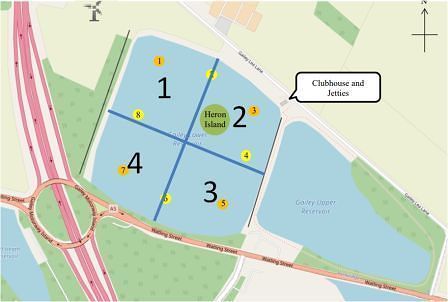Level 1 - Lesson Plan
Aim of course:
The aim of Level 1 is to give students a basic understanding of sailing, its terminology, develop the ability to dress appropriately, rig, launch, sail and turn in all directions, right a capsize, recover and derig a boat, all through relaxed tuition for the purpose of safe
and enjoyable recreational sailing. The course offers students the opportunity of learning in doublehanded dinghies.
To book please find your preferred course on the calendar or book online tab and buy the appropriate ticket/s.
Boats
Double-handed:
The GP 14 (General Purpose 14-foot dinghy) which can be cruised, raced, rowed or even powered by a small outboard motor. As a training boat it is stable and large enough to accommodate an instructor and two students. The GP14 is raced as a two person adult class at SSSC. This option is best for those who take a more considered approach to learning and like to understand the theory.
OR
The RS Quest. A modern polyethylene 14 foot sailing dinghy that can be comfortably sailed with 2 but large enough to accommodate up to 5. It is ideally suited to training due to its roominess and stability and has recently been introduced into the club but specifically as a training boat only. This is to avoid influencing trainees toward a specific class of boat when it comes to buying one to sail at the club.
Instructor ratio
Double-handed:
Will operate on ratio of 1:2 with a maximum of 6 students.
SI:
The SI will have an overview of the Doublehanded course, monitoring any safety issues ensuring the standard of course delivery and timely progress through the sessions by the DI's. The SI will brief and debrief DI's as required.
Course delivery
Classroom, Onshore and Onwater sessions will be by DI's in accordance with the relevant method.
Course structure Overview:
Day 1:
Double-handed |
|
Equipment, wind, boat orientation & rigging |
|
Launch & familiarisation |
|
Basic boat controls, beam reach |
|
Land drill Going about |
|
Going about |
|
Sailing to windward |
|
Five Essentials |
Day 2:
Double-handed |
Sailing Downwind |
Land Drill - Gybing |
Gybing |
Sail triangular course, first Solo sail |
Further sessions (inc capsize drill) |
Detailed lesson plans
Equipment:
Fleet: GP14 or RS Quests
Safety boat: Highfield RIB
Classroom: Training Loft
Sailing areas:
The course will operate in sailing areas dependent upon wind direction.
Double-handed:
Will use the right hand jetty and sailing areas 3 & 4 or 1 & 4, depending on the wind direction.
DOUBLE-HANDED LESSON PLAN
DAY 1:
9:00 - 9:30 CLASSROOM:
- Introductions Instructors and participants
- Course outline
- Facilities and safety briefing (slipways, booms, ropes, dealing with capsizes, etc)
9:30 - 10:15 ASHORE:
- Intro to the parts of the boat & rigging
- Wind direction and awareness
- Rig & launch boats
- Check clothing and buoyancy aids
10:15 - 10:30 ON WATER:
- Familiarisation sail: Instructor on helm
- Reaching figure of eight,
- Wind awareness
- Students allocated tasks (jib sheets, observation)
- Students balance boat
10:30 - 10:45 ASHORE:
- Coffee Break
10:45 - 11:45 ON WATER:
- Basic boat controls on a beam reach (students on helm except when going about)
- Lying to
- Sails and sheets
- Rudder and tiller
- Centreboard
11:45 - 12:15 ASHORE:
- Land drill going about
12:15 - 13:00 LUNCH / DEBRIEF
13:00 - 13:45 ON WATER:
- Practice reaching and going about back to a reach
- Coming alongside the jetty (demo)
13:45 - 14:15 CLASSROOM:
- Points of sail and no go zone
- Introduction to the Five Essentials
14:15 - 14:30 ASHORE:
- Coffee Break
14:30 - 15:30 ON WATER:
- Upwind sailing, Shallow triangle (no gybing)
- Finding No-Go Zone
- Improving goiing about
- Getting out of irons (Push Push - Pull Pull)
15:30 - 16:00 ASHORE:
- De-rig
16:00 - 16:30 CLASSROOM:
- Wind (onshore, offshore)
- Beaufort Scale, know before you go
- Knots & uses: figure of eight, round turn & two half hitches, cleating
- Debrief & questions
DAY 2:
9:00 - 9:30 CLASSROOM:
- Questions from day 1
- Recap going upwind, tacking and course made good on a beat
- Introduction to downwind sailing, training run
9:30 - 10:30 ON WATER:
- Rig & launch boats
- Downwind sailing
- Bearing away
- Finding training run using jib
- Use of 5 Five Essentials
- Instructor to demonstrate gybe on final run
10:30 - 11:00 ASHORE:
- Gybing, land drill
11:00 - 11:15 ASHORE:
- Coffee Break
11:15 - 12:00 ON WATER:
- Leaving the jetty
- Gybing(triangular course)
- Coming alongside the jetty
12:00 - 12:30 CLASSROOM:
- Rules of the road (Port/Starboard, Windward/Leeward, Overtaking boat)
- Capsize theory
12:30 - 13:15 LUNCH / DEBRIEF
13:15 - 14:00 ON WATER:
- Sailing a triangular course, (with instructor in the boat)
- Demonstrate five essentials
- First Solo sail
14:00 - 14:30 ASHORE:
- Capsize theory
14:30 - 15:15 ON WATER:
- CAPSIZE (not compulsory, but do it if conditions permit) de-rig all but one boat before capsize
- Boat on line from jetty or buoy
- Swim around back, use board to right boat
15:15 - 15:30 ASHORE:
- Coffee Break
15:30 - 16:00 ASHORE:
- De-rig
16:00 - 16:30 CLASSROOM:
- Debrief and questions
- End of course procedures: log books and next step
Last updated 20:19 on 8 December 2025


